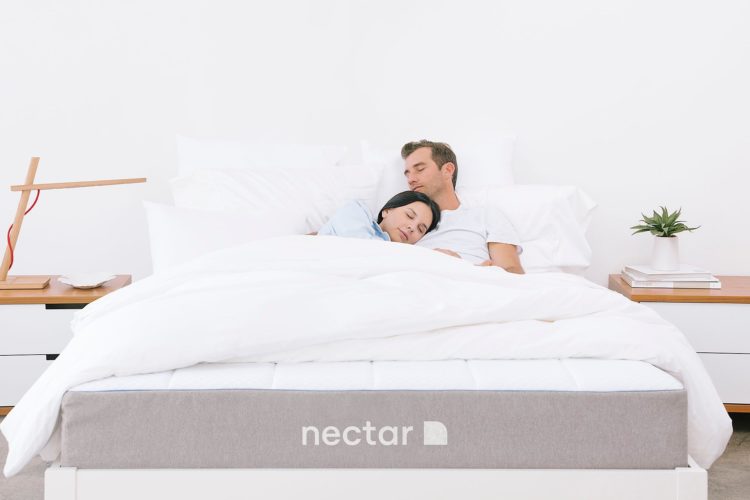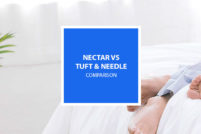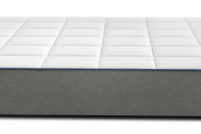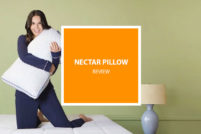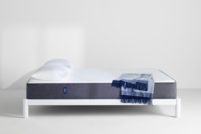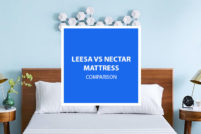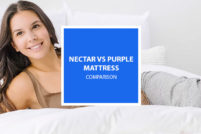The Nectar mattress features multi-layered construction and is 11 inches in height. Its layers are comprised of gel memory foams and a thick foundation as its base layer.
The Tuft & Needle mattress works on a “simpler is better” model and has only two layers – a thicker, 7-inch base layer of foundation foam and an upper layer of proprietary T&N Adaptive foam, for a total height of 10 inches.
Both get great feedback from sleepers of most body types and they are suitable for most back, stomach and side sleepers. They are also both quite cooling, making them great options for hot sleepers and both include gel materials in their upper layers, to lower the bed temperature.
While the Tuft & Needle’s top layer is an adaptive foam, it contains no memory foam in its construction, while the Nectar mattress has three separate layers of memory foam. So even though they both rate as medium-firm, the Tuft & Needle mattress is slightly firmer and has a quicker responsiveness rate than the Nectar mattress.
And, although Tuft & Needle offer a decent 100-night sleep trial and 10-year warranty, it can’t really compete with Nectar’s “forever” warranty and one year sleep trial period. Both are great mattresses with thousands of positive reviews, but keep reading to learn more, so you can decide which one is best for you.
4 Reasons to Pick the Nectar or the Tuft & Needle
No time to read the full comparison? Here are 4 reasons to buy either the Nectar or the Tuft & Needle:
Pick the Nectar Mattress If:
- You sleep hot – The Nectar bed has multiple cooling features that are getting great feedback from hot sleepers. Between its gel memory foam layers and its support, which provides a floating-on-top feel, rather than a sinking-in hug, customers are reporting that this is a good pick for sweaty sleepers.
- You want a long sleep trial period and warranty – The Nectar’s can’t be beat. If you’re new to the all-foam mattress world or you’re just generally not sure if this is the bed for you, the Nectar has little risk when it comes to their return policy and warranty.
- You want a firmer memory foam bed – Providing a medium-firm level of comfort and multiple memory foam layers, the Nectar bed provides everything that is good about memory foam without all the hot, enveloping hug of a soft memory foam bed. If you like the idea of memory foam but don’t like sinking into your bed, this might be a good pick for you.
Pick the Tuft & Needle Mattress If:
Last update on 2024-04-14 at 16:02 - More InfoProduct prices and availability are accurate as of the date/time indicated and are subject to change. Any price and availability information displayed on Amazon.com at the time of purchase will apply to the purchase of this product." / Affiliate links / Images from Amazon Product Advertising API
- You are on a budget – A simple bed with just two layers, the Tuft & Needle bed is cheaper to make than other complicated, multi-layered mattresses and the savings are passed on to the customer. A great deal for a bed with so many positive reviews and with a decent warranty and sleep trial period to boot, the Tuft & Needle bed is a good option for those on a budget.
- You want a bed with basic construction – If you aren’t convinced that multiple layers and different, fancy materials are for you and you just want something simple, the Tuft & Needle is a no-nonsense bed made for most people. If you’re not sure about an all-foam bed and you want to start basic without sacrificing quality or comfort, the Tuft & Needle bed is a good pick.
- You want a foam mattress but you don’t like memory foam – Some people like the idea of a foam bed but hate the idea of memory foam, no matter how firm. If you want to try a firmer foam bed without any of that memory foam feel, you might want to try a Tuft & Needle mattress.
Construction

As mentioned above, there are some stark differences when it comes to the construction of the Nectar and Tuft & Needle mattresses.
The Nectar mattress is built with four layers of foam, starting at the top with a top layer of quilted, gel memory foam. This quilting creates loft in the overall feel of the bed and also works to promote air circulation.
Next down is another layer of gel memory foam. This semi-open Lush Foam is designed to be highly adaptive to all body types and provides cushioning and support in all sleeping positions.
It is also cooling and absorbs heat to draw it away from the body. Below this is a 3-inch layer of what the company calls Adaptive Hi Core memory foam. This is a transition layer, which means it acts as layer of support between the lower, firm, foundation layer and the upper, softer foam layers.
Since it is adaptive, it responds to the shape and weight of the body and has a bit of push back and bounce as compared with the upper gel memory foam layers.
The base layer of the Nectar mattress is built for durability and longevity. It is made with special air channels that draw cooler air from the outside area and it provides the stable foundation for the bed, by preventing sagging and absorbing motion.
To further promote its cooling properties, the Nectar mattress is wrapped in a Tencel and long-staple cotton cover. Tencel fabric is a natural, sustainable fabric made from wood cellulose. It is naturally antibacterial and known for its moisture wicking and quick drying properties.
Of course, cotton is also known for its great moisture wicking properties. The Tuft & Needle bed is also made of foam, but is only comprised of two layers. The thick, 7-inch base layer of foundation foam provides the firm base for the mattress, prevents sagging and absorbs motion and movement.
The upper layer of the mattress is a 3-inch layer of the company’s Adaptive foam. This is a high-density foam with very little sink and no sag. The company describes it as having the best features of memory foam or latex, without any of the side effects like sinkage.
This upper layer is infused with graphite and cooling gel, making it a great choice for hot sleepers. Their cover is made from a blend of micro polyamide and polyester, which the company says dries 6 to 8 times faster than cotton. Both mattresses feature foams that are CertiPUR-US certified against harmful or toxic emissions.
Firmness and Support

The Nectar mattress rates at about a 6 to a 6.5 in terms of firmness, which makes it medium-firm. This means that it’s a firmer bed for a memory foam mattress and it will have some nice cushioning, but don’t expect to be enveloped or wrapped in it like you would in a soft memory foam bed. Instead, you’ll have more of a floating on top feel.
The Tuft & Needle bed is also medium-firm but just a bit firmer than the Nectar, at about a 7 on a 10-point scale of firmness. It has no memory foam and so, while it isn’t hard, its Adaptive foam offers a decent amount of resistance in its cushioning. Both beds offer a great amount of support and alignment for the spine, due to their high-density base layers and firmer support throughout.
Motion Transfer and Sinkage
Both the Nectar Sleep mattress and the Tuft & Needle are getting great reviews for their lack of motion transfer, meaning they are great for those who sleep with other people and are light sleepers. The firm foundations of both beds are great at absorbing motion when getting in and out of the bed or when turning over to change positions.
The Nectar mattress has a slight advantage when it comes to motion transfer, because it has multiple layers to absorb movement and memory foam is notoriously good at this. In terms of sinkage, the results are similar.
Because the Nectar mattress has multiple, memory foam layers, customers report that they sink in just a little bit more compared with the Tuft & Needle bed. As the T&N company states, they want the benefits of memory foam and latex, without the negative attributes, like sinkage and hugging.
That adaptive latex-like responsiveness in the top layer of the Tuft & Needle mattress means it has a bit more bounce and push back than the Nectar mattress. Neither bed sinks or sags at all, but these subtle differences between the two are important when choosing which one is for you.
Temperature Regulation
Given that both these beds are rated as medium-firm, they are both two of the cooler all-foam beds on the market. Softer beds make you sink in, which makes more of the bed wrap around you, making you hotter, but with both the Nectar and the Tuft & Needle bed, you float on top, rather than sink in.
As well, both beds have cooling features to promote a better sleep for hot sleepers. The Nectar bed has three layers of cooling gel memory foam, with a quilted layer of memory foam in its top layer and breathable channels built into its base layer.
All of these features work to absorb heat and draw it away from the body, while keeping the bed surface cool. The Tuft & Needle bed also has cooling gel that is also graphite infused, to even further promote its heat drawing effects.
They keep things simple with these two, breathable layers and a breathable cover and say that if it doesn’t promote the feel or the airflow, they don’t add it.
Sleep Position and Body Type
The multiple layers of memory foam in the Nectar mattress offer a nice amount of cushioning, making it especially great for side sleepers and since it’s not too soft, stomach and back sleepers won’t find their hips sinking in, so long as they are of average weight.
Overwhelmingly, even heavier customers over 250 pounds seem to be generally satisfied with the Nectar, although some just don’t do well with an all-foam mattress – the heavier you are, the bigger of a problem this will likely be. And, if you are a smaller, lighter customer, you might find the Nectar bed a bit too firm for your liking.
Although it has memory foam, it’s still a medium-firm bed and, if you are smaller (under 130 pounds), you might not get the benefit of those lower memory foam layers. Again, overwhelmingly, most customers are happy with the Nectar mattress. The same goes for the Tuft & Needle mattress.
As a firmer mattress, it offers a nice amount of resistance, with even less sink than the Nectar. It has a bit of responsiveness and bounce, due to its T&N Adaptive foam top layer, so it supports the body and regains its original position quickly, when moving around.
Like the Nectar mattress, there are no issues with sagging here and customers in all sleep positions are generally happy with this bed. While the Tuft & Needle mattress seems to suit most people and even most body types, with a 95 percent satisfaction rate, a few heavier stomach sleepers have mentioned that this bed took some time to get used to.
Some heavier side sleepers found the Tuft & Needle mattress a bit too firm and some purchased an extra mattress topper. This is likely due to the fact that the Tuft & Needle has only one comfort layer and it’s not thick enough to provide adequate cushioning for some bigger people, making them sink down to the lower and harder base layer.
Some smaller customers have also found benefit in an extra mattress topper on the Tuft & Needle and this is not that surprising as firmer all-foam mattresses don’t always have enough cushioning and sinkage for smaller frames who may have bonier hips and shoulders.
Both beds have a minimal amount of sinkage when sitting or sleeping on the edge of the bed, but nothing out of the ordinary for all-foam mattresses – they are going to have more edge sinkage than an innerspring bed. If you are a heavier customer who likes to sleep on the edge of the bed, an all-foam bed may not be for you.
Sleep Trial and Warranty
Nectar’s sleep trial period can’t be beat. The company offers a full year to get to know the bed and to make sure it’s for you. They say that less than 3 percent of customers end up returning the Nectar bed, but just in case, if you aren’t satisfied with it, they’ll pick it up free of charge and give you a full refund.
Their warranty is also unparalleled. While most mattress companies offer a 10 or 15-year warranty, the Nectar’s warranty is FOREVER. Boasting no small type or legal speak, the warranty for the Nectar bed covers any break from normal use at any time during your use of the bed.
If it happens, they’ll replace the bed free of charge, no matter how much time has passed. That’s pretty impressive. Not only that, but they guarantee their mattress against permanent sagging, compression or impressions that don’t go away. If at any time your bed gets permanent indents over 1.5 inches or more, they will replace the bed.
Tuft & Needle offers a 10-year warranty, which is on par with what most other companies are offering. Their sleep trial period is also comparable, at 100 nights. If you don’t like the mattress after your sleep trial period, they’ll refund you, pick up the bed and donate it to a charity of your choice.
It’s that simple. It’s also good note that while the warranty and sleep trial period of the Tuft & Needle can’t compete with Nectar’s, they’re a company that’s been around for a bit longer and has had some time to iron out the kinks.
For all the amazing feedback the Nectar has been getting, their main issue seems to be with actually getting the product out the door and into people’s homes.
Struggling to meet demand and dealing with a product made offshore, the Nectar company claims on their website that their backlog issues have been resolved but recent reviews suggest otherwise and customers often have a hard time getting in touch with this new and expanding company. Just something to keep in mind when making your choice.
Conclusion
So, now you should have a bit more information as to what sets these two mattresses apart. Both medium-firm beds, with the Tuft & Needle offering a slightly firmer feel due to its lack of memory foam.
The Nectar bed offers cooling, memory foam gel layers and a long sleep trial and warranty but lacks in the years of experience that Tuft & Needle has and has been struggling a bit to keep on top of things.
They offer a no-frills, easy, two-layer bed, without too many bells and whistles, which they say end up costing the customer more but don’t really provide anything extra.
They both come in at a great price point for all-foam beds and have a decent sleep trial periods and warranties. Take your pick, two different but high-quality options for those looking for a firmer foam bed.
